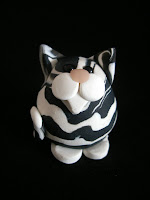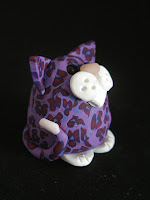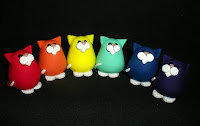 I made a collection of six Millefiori Cats after wanting to experiment more with flower canes, having still had a hankering to create a flowery cat! For the cane, I used a pink log for the centre, then five petals of purple clay, each with an outer layer of white.
I made a collection of six Millefiori Cats after wanting to experiment more with flower canes, having still had a hankering to create a flowery cat! For the cane, I used a pink log for the centre, then five petals of purple clay, each with an outer layer of white.Then I used a pearl lilac clay to fill the space between the petals, and as an outer border. This made the flowers appear standalone. I then reduced the cane down to three different sizes.
 For the first pair of cats (top right), I applied thin slices of the single flower cane to the clay core and then blended them in afterwards. This had the result of increasing the size of each flower to 7-8mm in diameter. The Short Cat as a bit of a floppy ear, which gives hima rather soulful look!
For the first pair of cats (top right), I applied thin slices of the single flower cane to the clay core and then blended them in afterwards. This had the result of increasing the size of each flower to 7-8mm in diameter. The Short Cat as a bit of a floppy ear, which gives hima rather soulful look!For the second cats (left), I used the pearl lilac clay for the core and inlaid single smaller flowers and blended them with the core. Having the core and the background to the flower cane the same colour allows the flowers to appear defined by their petals.
 The inlay method worked well as I was able to blend the background colour with the core clay, making the flowers almost seemless. The flowers have a diameter of 5-6mm.
The inlay method worked well as I was able to blend the background colour with the core clay, making the flowers almost seemless. The flowers have a diameter of 5-6mm.For the third cats (bottom right), I had reduced the large flower cane and cut it into seven segments, and then put those segments together to create a new flower and reduced that cane down further. This resulted in each individual flower measuring about 2-3mm, and gives the more classical millefiori effect.
The Tall Cats stand about 5.5cm tall and 2.5cm wide, and the Short Cats are just under 4cm tall and 2.7cm wide. They are listed for sale my shops at Folksy.com and Etsy.com.














 After experimenting with rolling cut out shapes onto the clay body, I tried the true inlay method, where I cut out the shape I was going to insert, cleared out all the clay, and then placed the new shape to match. This was painstaking work, hence the rather small number of hearts on this cat (also 4.5cm tall). I also inserted a pink heart in each ear, although it's a little hard to see this in the photograph.
After experimenting with rolling cut out shapes onto the clay body, I tried the true inlay method, where I cut out the shape I was going to insert, cleared out all the clay, and then placed the new shape to match. This was painstaking work, hence the rather small number of hearts on this cat (also 4.5cm tall). I also inserted a pink heart in each ear, although it's a little hard to see this in the photograph.




























